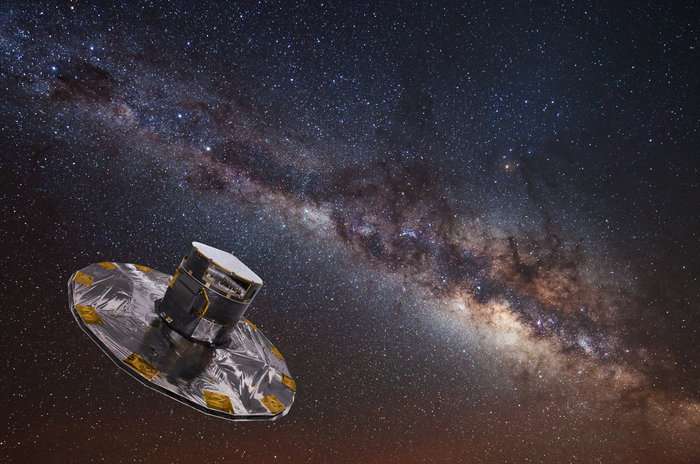September 25, 2017 report
Researchers analyze chemical composition of the newly discovered star cluster Gaia 1

(Phys.org)—A team of astronomers led by Andreas Koch of the Lancaster University, U.K., has recently conducted a detailed chemical abundance study of the recently discovered star cluster Gaia 1. The research, published Sept. 12 on arXiv.org, offers new insights into the nature of this newly found cluster.
Gaia 1 is a large, massive, nearby star cluster first identified in May 2017 in the Data Release 1 (DR1) from the Gaia space observatory operated by the European Space Agency (ESA). Located some 15,000 light years away from the Earth, this cluster has a half-light radius of about 29 light years and a mass of approximately 22,000 solar masses.
Although fundamental parameters of Gaia 1 are known, the researchers are still uncertain about its age, metallicity and origin. The cluster was initially classified as an intermediate-age (6.3 billion years old), and moderately metal-rich system. However, further studies found that Gaia 1 is about 3.3 billion years younger and more metal-rich than previously thought. Moreover, some astronomers have suggested the possibility of extragalactic origin for Gaia 1, given that its orbit leads it up to 5,500 light-years above the Milky Way's disk.
Now, Koch's team has performed a new chemical analysis of Gaia 1 with the aim of clarifying these uncertainties. The researchers have measured detailed chemical abundances of 14 elements in four red giant members of the cluster.
"This work focuses on a detailed chemical abundance analysis of four red giant members of Gaia 1, based on high-resolution spectroscopy, which we complement by an investigation of the orbital properties of this transition object," the authors wrote in the paper.
The four stars were observed with the Echelle spectrograph at the 2.5-m du Pont telescope at the Las Campanas Observatory, Chile. Besides the previously estimated iron content, this instrument allowed the researchers to obtain abundances of lithium, carbon, oxygen, magnesium, aluminum, silicon, calcium, titanium, scandium, vanadium, chromium, cobalt, nickel and zinc.
The analysis revealed that Gaia 1 is associated with the Milky Way's thick disk and is more metal-poor than previously estimated. Moreover, they suggest that the system is a massive open cluster rather than a low-mass globular cluster.
"Our abundance analysis revealed alpha abundances that are consistent with the thick disk (...) Despite the presence of mild light element variations in Na, Mg, and Al no obvious (anti-) correlations are seen between those elements as would be expected in galactic globular clusters. Since its stellar mass of a few ten thousand solar masses places Gaia 1 at the boundary between very low-mass globular clusters and very luminous open clusters, our analysis rather comforts the latter view," the paper reads.
In concluding remarks, the scientists noted that the exact formation and origin of Gaia 1 still remains unclear. They hope that the Gaia satellite could deliver crucial data such as precise and accurate parallaxes that could be helpful in resolving this issue.
More information: Detailed chemical abundance analysis of the thick disk star cluster Gaia 1, arXiv:1709.04022 [astro-ph.GA] arxiv.org/abs/1709.04022
Abstract
Star clusters, particularly those objects in the disk-bulge-halo interface are as of yet poorly charted, albeit carrying important information about the formation and the structure of the Milky Way. Here, we present a detailed chemical abundance study of the recently discovered object Gaia 1. Photometry has previously suggested it as an intermediate-age, moderately metal-rich system, although the exact values for its age and metallicity remained ambiguous in the literature. We measured detailed chemical abundances of 14 elements in four red giant members, from high-resolution (R=25000) spectra that firmly establish Gaia 1 as an object associated with the thick disk. The resulting mean Fe abundance is −0.62±0.03(stat.)±0.10(sys.) dex, which is more metal-poor than indicated by previous spectroscopy from the literature, but it is fully in line with values from isochrone fitting. We find that Gaia 1 is moderately enhanced in the α-elements, which allowed us to consolidate its membership with the thick disk via chemical tagging. The cluster's Fe-peak and neutron-capture elements are similar to those found across the metal-rich disks, where the latter indicate some level of s-process activity. No significant spread in iron nor in other heavy elements was detected, whereas we find evidence of light-element variations in Na, Mg, and Al. Nonetheless, the traditional Na-O and Mg-Al (anti-)correlations, typically seen in old globular clusters, are not seen in our data. This confirms that Gaia 1 is rather a massive and luminous open cluster than a low-mass globular cluster. Finally, orbital computations of the target stars bolster our chemical findings of Gaia 1's present-day membership with the thick disk, even though it remains unclear, which mechanisms put it in that place.
© 2017 Phys.org





















